The use of diesels on the Royal Train workings was a natural consequence of the replacement of the steam locomotive fleet during the 1960's. And like their steam predecessors the diesels chosen for these workings were specially prepared in order to recognise the Royalty they would be hauling. Pre-requisites for the choice of locomotives required that they be able to heat the train and generally they would be used in pairs.
Since the Royal Train was housed and maintained at Wolverton it is no surprise that the Class 25's would feature prominently, not only in hauling members of the Royal Family, but also in the movement of the empty Royal train stock to and from Wolverton. These movements also allowed the Class 25's to visit locations where they would not normally be found on their regular more mundane day to day duties.
Because of the proximity of Wolverton to London it should come as no surprise that certain member of the Cricklewood/Willesden allocation of Class 25's would become regular performers on the Royal workings. These locomotives were often easily identified by their clean paintwork and the embellishments on such items as the pipework, buffers, wheelrims and axleboxes. The train crews would also have use of portable two-radio equipment. The use of this equipment led to a minor external modification on the Class 25 cabfronts. A small circular metal plate covered a small hole drilled through the cab sheeting provided a means to run the cabling for the radios between the paired locomotives and the Royal train coaches.
The notes below are an incomplete record of the Royal train workings during the life of the Class 25, and initially they focus mostly on the LMR/ER/ScR workings, until the others can be filled in!
1961
I have no clue when the Royal Train was first worked by a diesel, but on June 8th 1961 a Royal wedding reception was held at Hovingham following the marriage of Prince Edward Duke of Kent and Miss Katherine Worsley, just married at York Minster, which required a Royal train to work from Malton. The train itself was hauled to Kings Cross by 60028 Walter K Whigham, but the empty stock was brought in from York by English Electric Type 4 D281. Two trains for the guests were also provided, the empty stock of one being worked to Malton by D284.
1965
On the evening of October 21st a Royal Train operated from St Pancras to the Leeds area, as detailed below:
21/10/65 St Pancras 22.30
22/10/65 Leeds City South 03.40 - 03.50 - Locomotive Change
22/10/65 Stabled Kippax Branch 04.20 - 10.10.
22/10/65 Crossgates 10.30.
Although the locomotives have not been identified (it was diagrammed for two Type 2s, with Cambridge Street men to Leicester & Leicester men to Leeds), it has been suggested that the two two-tone green Class 27s (D5380 & D5382) may have powered the train to the Leeds area. Both had recently been shopped at Derby Works, being present on August 15th 1965 & October 3rd but were not there on October 24th 1965. It is most likely that during these visits to Derby Works the two-tone green livery was applied.
The purpose for the Queen's visit was to open the new Seacroft shopping centre in Cross Gates, then proceeding to York for an event at the University of York. The return Royal Flight was cancelled due to fog, a standby train ran from York at 17.15, arriving Kings Cross at 20.28.
1967
On May 11th a Royal Train was booked as the 22.30 St Pancras to Oakham (no further details at this time, but booked for a pair of Class 25s).
1968
On May 2nd the Royal Train was noted at Oxford behind D827 & D822, when the Queen was visiting the city.
On May 9th (or 11th?) St Pancras was host to the Royal Train which was booked to leave at 22.30 to Nottingham via Manton, hauled by D5223 & D5226. The next day (10th) D5223 & D5226 hauled the same train from Worksop to Matlock via Chesterfield. Later the same day Royal train headed south being noted passing through Banbury.
1969
The Duke of Edinburgh’s visit to the Yorkshire area on June 26th utilised a four coach train hauled by ‘Royal Regulars’ 5226 & 5223 from Moston.
The Investiture of the Prince of Wales at Caernarvon created much special traffic for the region, including the use of Class 40’s 216 & 233 on the Royal Train. The only recorded use of a Sulzer Type 2 was the stationing of 5080 at Caernarvon as a shunting locomotive! The Household Cavalry and a section of the Metropolitan Mounted Police made the trip from Kensington Olympia to Caernarvon. Willesden’s Class 25’s were used for the short hop to the WCML, the heavy train comprised three baggage vans, twenty seven horse boxes and three corridor coaches. Three trips were made on June 23 - 25, returning July 2 - 4.
1970
'Royal’ duty of a sort occurred on May 5th when 67 ‘Royal Artilleryman’ arrived at Newark with a special containing eighty one horses and 127 men of the King’s Troop, Royal Horse Artillery for the Newark Agricultural Show. The train had originated at Windsor and came via the Bottesford branch, how far the Peak worked the train from is not recorded.
The Royal Train again received Class 25 haulage on May 9th when 5206 & 5223 worked the Queen Mother from Selly Oak to Bedale (for Catterick) where the train stabled overnight before returning to Wolverton as empty stock the next day.
On July 18th 223 Lancastria & 215 Aquitania ran light from Wigan to Willesden, staying here overnight. On the Sunday afternoon they were at Wolverton to pick up the Royal Train and deliver it to Bristol via Birmingham & Worcester. That evening (19th) they headed to Glasgow with the Duke of Edinburgh onboard. On the Monday they returned the empty stock to Wolverton and the two Class 40s returned light engines to Wigan.
Two weeks later on July 30th 233 Empress of England conveyed the Royal Train from Birmingham to Coventry with Her Majesty The Queen on board. The empty stock continued from here to Wolverton, The Queen returned by other means.
1971
225 Lusitania & 216 Campania were in charge of the Royal Train comprised of seven coaches visiting Barrow on June 10th.
At about 5pm on June 24th 5206 was noted at Liverpool Lime Street with some empty Royal Train stock.
On June 29th 7578 took a four coach Royal train from Edinburgh to Dumbarton.
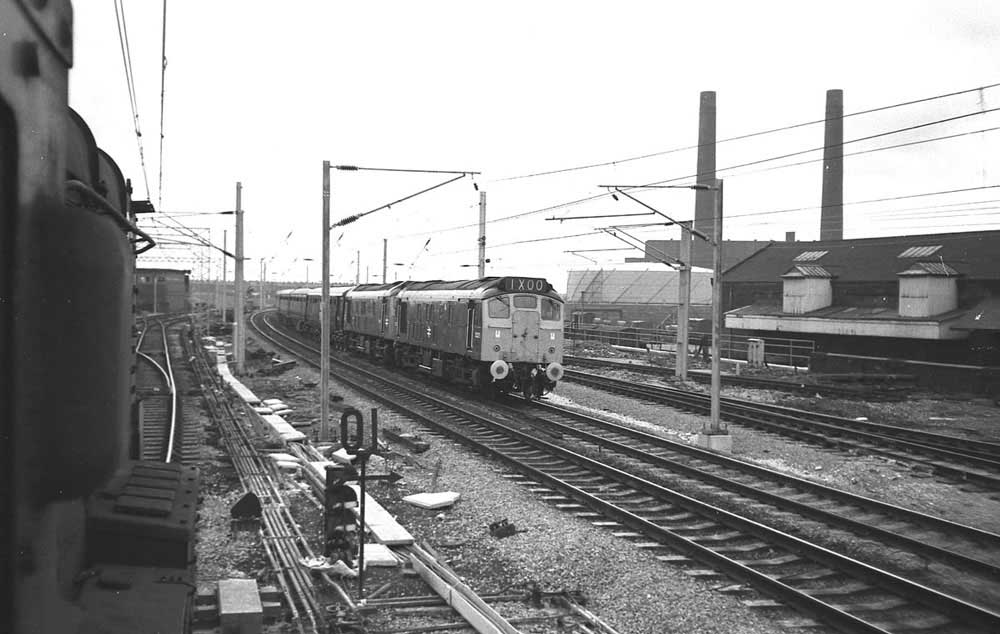
On October 14th the Queen was in attendance at Huddersfield to open the M62 motorway. The seven vehicle Royal Train had departed Euston at 09.35am, with Class 40s 216 & 225 taking over at Stockport, running via Denton Junction, Ashton Branch siding, Hebden Bridge and Bradley Wood Junction. From Huddersfield the train ran empty to Accrington, then Leyland, where the Royal Party rejoined the train.
1972
On July 14th 5221 & 5218 returned the empty stock of the Royal Train from Donnington (Salop) to Wolverton following a visit by the Duke of Edinburgh to Telford.
When Her Majesty The Queen visited the Royal Show at Stoneleigh on July 5th the train was worked into Coventry by 216 Campania & 313 with nine coaches.
November 16th saw 5221 & 5222 convey a five coach Royal Train with Princess Anne aboard from Euston to Hope. The train returned ecs to Wolverton via the Midland to Market Harborough. This five coach formation contained the LMR General Managers saloon (M45000M), this did not normally accompany the Royal Train but was required because two Royal Trains were in use this day.
On December 10th Royal Train stock was worked from Wolverhampton to Southampton to provide an evening departure from here to Barry, a Class 52 was booked to haul the train. Her Majesty The Queen and The Duke Of Edinburgh were conveyed, the train stabled for part of the night on the Sudbrook branch with 6886 providing heat.
1973
Royal Train duty befell 5218 & 5219 on February 14-16th. The Duke of Edinburgh journeyed from Euston, at 23.00 to Sheffield via Northampton & Leicester. Twenty four hours later he returned to Lamport, near Market Harborough, with the five coach train stabling overnight, before leaving at 7am for Leatherhead via the West London line, Clapham Jcn, Selhurst, West Croydon & Sutton. On return the Class 25’s ran through to Dorking, here they ran round and headed back to Wolverton via Sutton, Mitcham Jct & Clapham Jct. Overnight heating was provided by a heater van delivered by 5221.
Class 40's 309 & 308 were noted heading in the London direction through Reading on the evening of May 25th with four Royal Train coaches presuambly en-route to Aberdeen to collect members of the Royal Family and return them to London on the night of May 29th/30th. Eight vehicles were used on the southbound trip, the pair of Class 40's were exchanged at Newcastle by 1970, with 1988 as standby. The next night four Royal Train vehicles were attached to the 23.15 Kings Cross - Edinburgh as far as Newcastle, with the Duke of Edinburgh aboard. From Newcastle the four coaches were taken to Sunderland by 5856, and then later ECS to Wolverton.
1974
25072 & 25068 worked a five coach Royal Train (coaches 5154, 45006, 45005, 2901 & 5165) from Euston for Manchester on May 21st/22nd for the Prince of Wales to attend a function in the city on the 22nd. The train departed Euston at 23.15 on the 21st and reached Madeley at 01.31 on 22nd. Here 24053 from Crewe and a heater van and BSK drew the train onto the Madeley chord. The train locomotives were sent to Crewe depot, returning from there at 06.25am to take the train forward to Manchesster. The Royal Train returned empty from Manchester, departing 10.26am to Oxford on the 22nd.
Two days later (May 23rd/24th) the Prince of Wales visited Welshpool with the same stock and locomotives from the 21st's trip. The train departed Oxford at 23.10 on May 22nd for Wellington, here another Class 25 from Bescot with a heater van and a BSK from Oxley would draw the train on to the Dorrington branch, the train locomotives were sent to Shrewsbury, stabling there until 06.10am when they returned to the Royal Train to take it forward to Welshpool.
On May 6th 25068 & 25069 were used to take the Queen, on the Royal Train from Scunthorpe to Lowton and on to Preston. Here the Queen would unveil a plaque to mark the completion of the WCML electrification.
At Preston 25233 and a saloon was used to transfer the Queen from Preston station to the new Preston Power Box. After this adventure the Queen travelled north to Carlisle in the cab of 87018.

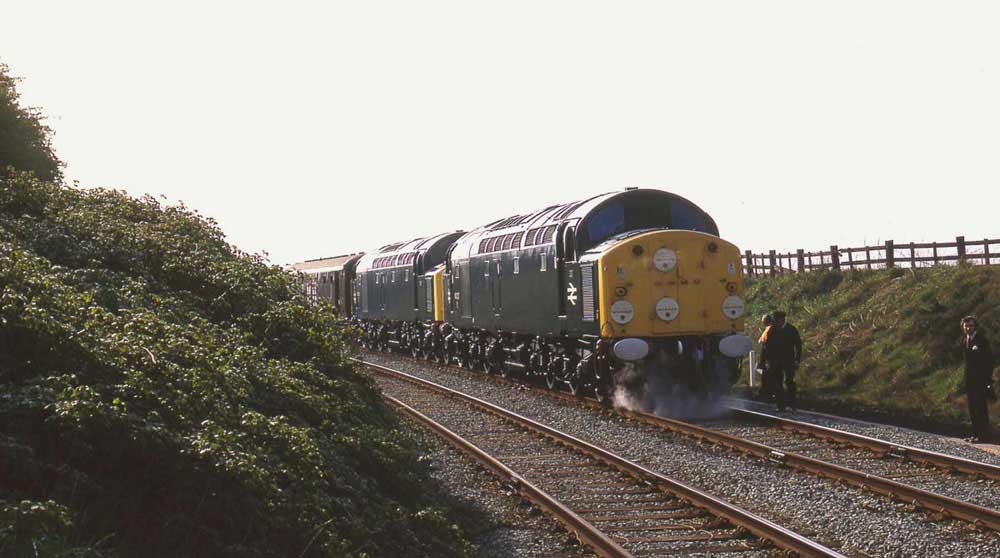
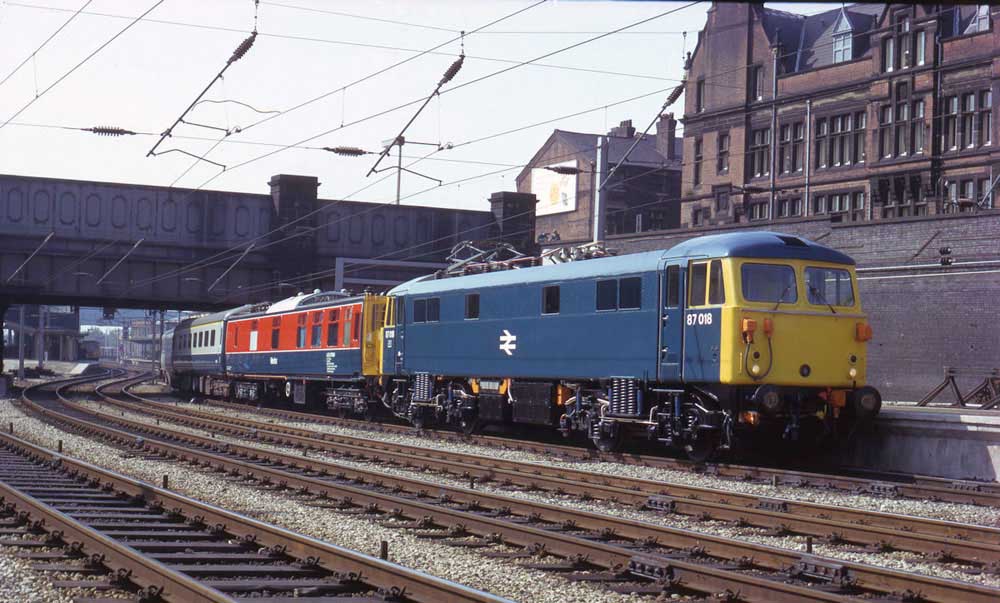
On November 6th the empty Royal Train was taken to Kings Lynn by 25069, the locomotive returned south whilst the Royal Train later headed out to Balmoral. The next day this train was noted at Dundee behind 27004 & 27107, both in immaculate condition.
1975
25054 & 25055 were on Royal Train duty on May 14th arriving at Kings Lynn with the stock for a late evening departure for the Duke of Edinburgh. The train ran to Salford via Peterborough, Grantham, Nottingham, Chesterfield, stopping overnight at Bamford.
Ex-works 25040 was used to assist the Royal Train from Wellington to Trench Crossing on May 28th 1975 for overnight stabling.
On June 17th 25051 & 25053 brought the Royal Train empty stock back from Edinburgh to Wolverton, via the ECML.
On November 18th the arrival of the President of Tanzania at Gatwick saw the Royal Train in use to Victoria, afterwards 25072 arrived at Stewarts Lane to return the stock to Wolverton.
1976
On 20th February four Royal Train coaches were brought into Edinburgh by 25048 & 25053.
A couple of Royal train workings occurred during June, on 2nd for Derby Day (Victoria – Tattenham Corner) & 22nd for the French President (Gatwick – Victoria). In both cases Class 31’s were used for the workings but 25071 (2nd) and 25222 (22nd) were used to get the coaching stock back to the LMR – Wolverton?


1977
On May 3rd HM The Queen & the Duke of Edinburgh visited Barrow behind 40019 & 40025 to witness the launching of HMS Invicible.
Carlisle depot was host to 25057 & 25218 and some of the Royal Train stock on May 18th.
With 1977 being the Jubilee Year for Queen Elizabeth II, the monarch and family made many public appearances, making considerable use of the new Royal Train. A morning visit to Stockport on June 21st saw the Royal Train visit Hazel Grove behind 47455. After transfering the Royal Family to road transport the Royal Train was taken away by 47491. Later that day the Royal Train was utilised for the journey to Porthmadog. The journey west of Shrewsbury was handled by 25221 & 25222. After staying overnight at Porthmadog the train ran to Harlech, where the Royal Family took to road transport. From Harlech the empty coaching stock was returned eastwards followed by the standby locomotive 25218.
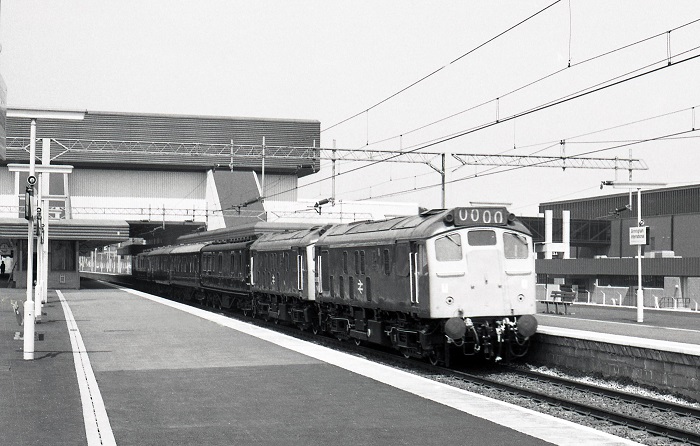
The Jubilee celebrations contributed to the further weakening of the BR corporate blue image mentality. The first cracks took place with the announcement that Classes 50 & 87 were all to receive names, an event not seen since the middle 60’s. And on the ER (GE) the 08.30 Liverpool St - Norwich and 15.48 return, with effect from June 6th were named ‘The Jubilee’. For these duties Stratford provided smartly turned out 47163 & 47164, but sporting silver roofs and large painted ‘Union Jacks’ carried on the bodyside at No 1 end! Over on the GN section the 07.45 Kings Cross - Edinburgh and 15.00 return were named ‘The Silver Jubilee’, Deltic hauled of course, on the first day, June 8th saw 55012 & 55022 in charge, but carrying no embellishments.
On July 22nd an ex-works 47529 hauled the Royal Train to Leicester with the Duke of Edinburgh on board. The return was from Melton Mowbray. 25221 & 25222 were noted on July 26th bringing the Royal Train ecs from Wolverton to Newcastle, via Carlisle. At Newcastle Princess Anne boarded for the journey to Dumfries.
For the tour of the West Midlands on July 27th the Royal Train left Euston on the evening of 26th behind 87004. At Berkswell 47545 took over the train, stabling on the short remains of the Kenilworth branch for the night. The next morning the immaculate 47529 reappeared and took the train to Stechford, Aston & Bescot to Wolverhampton to allow a visit to the Goodyear factory. The Royal Train then returned ecs to Coventry for a teatime departure to Birmingham International. Delays were incurred due to the large crowds in attendance. 47529 worked the train to Old Dalby where 47514 was ready to take over for the next day's duties. On the morning of 28th 47514 took the Royal Train to Derby where Her Majesty The Queen presented the newly designated city with its charter. Visits were then made to Chesterfield & Nottingham.
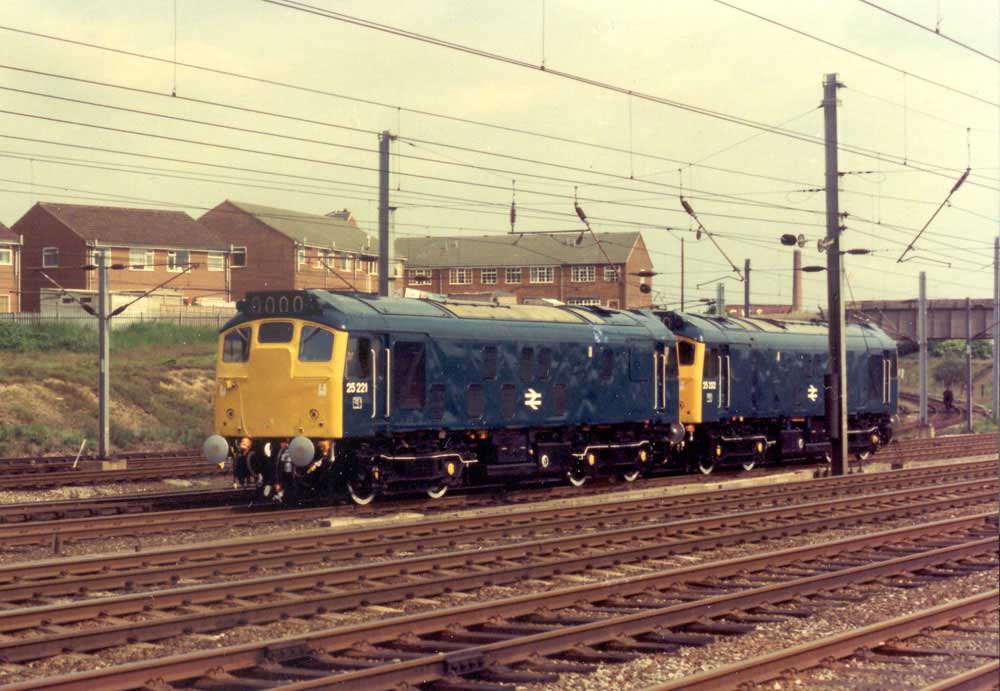
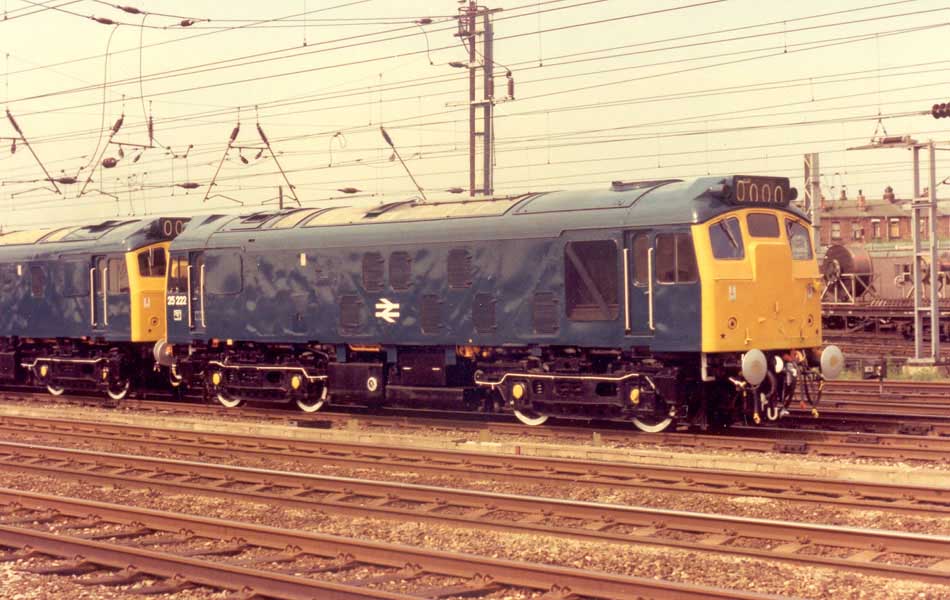
1978
Celebrations in honour of Captain James Cook found 47527 and a four coach Royal Train working from ? to Ormesby on June 1st 1978.
On July 14th 1978 Prince Charles made a visit to Bangor from ? 25220 & 25221 were in charge of the train as it arrived at Bangor, whilst 25219 was used to shunt the stock at Bangor, the empty coaching stock later headed east.
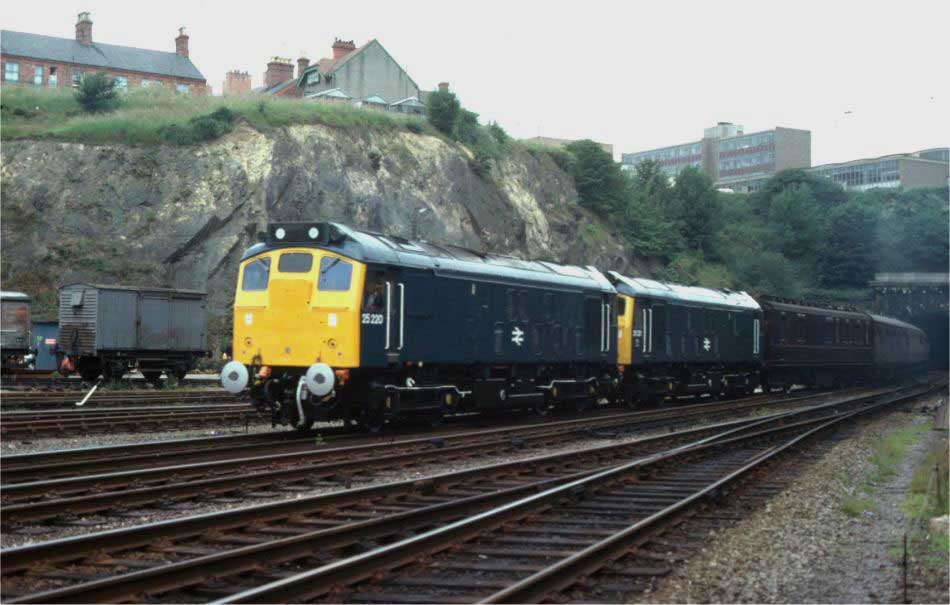
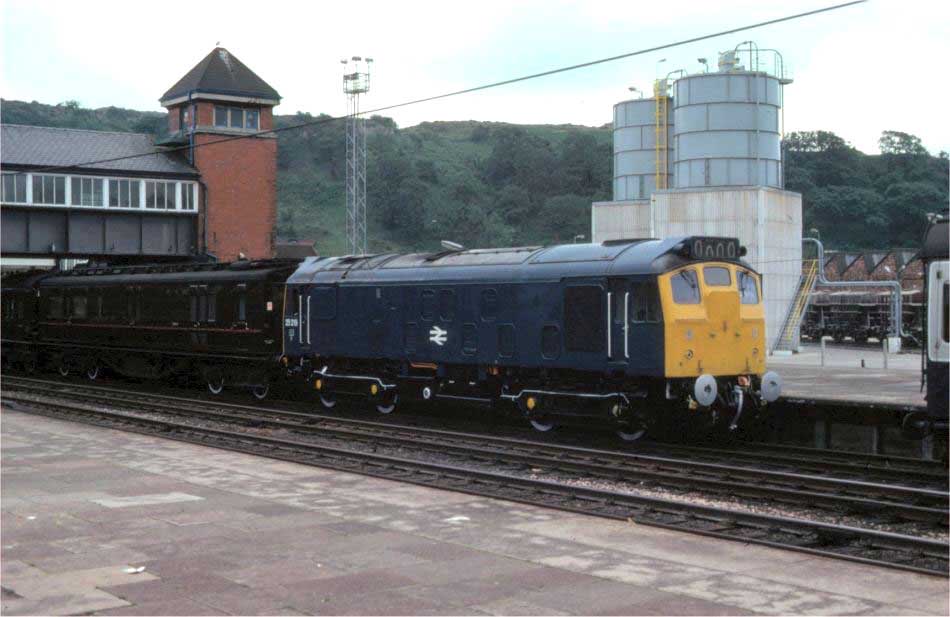
1980
On July 11th 1980 47555 was noted hauling Prince Charles as he travelled to formally reopen the combined rail/road bridge over the Menai Straits. The original railway bridge had been seriously damaged by fire on May 23rd 1970. The bridge reopened to rail service during January 1972, whilst road improvements much later saw a second deck added to the structure for road traffic.

On November 13th the Royal Train arrived at Coventry behind 87002. It returned later that evening from Oxley behind 47555 to convey the Duke of Edinburgh to Lincoln. The next day the empty stock of the Royal Train was noted westbound through Newark Castle, possibly behind 47580. Also in the area was a very clean 47581, possibly the standby locomotive this day.
1981
When Her Majesty The Queen and the Duke of Edinburgh visited Coventry on July 12th for services at the cathedral, the Royal Train was hauled by 47449 with nine coaches, the train returned ecs to Wolverton. On July 18th the Royal Train was noted returning ecs from Humberside to Wolverton.
On July 29th following the wedding of the Prince & Princess of Wales the couple departed on the honeymoon from Waterloo to Romsey. The ecs had come from Clapham to Waterloo behind 73101, the three coach train left Waterloo behind 73142.
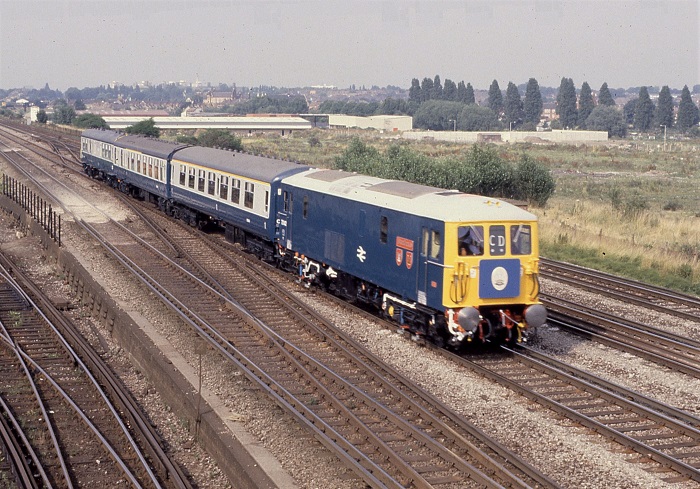
When the Prince & Princess of Wales visited Shotton on October 27th the Royal Train was hauled by 47449, the train having stabled overnight at Mold Junction. From shotton it ran ecs to Bangor, coming back later that night.
86244 worked the Royal Train from Euston to Berkswell on November 12th, stabling overnight here. The next day it went forward to Wellington behind a Class 47, the booked locomotive, 47449 had failed. Similarly 87028 worked the train to Berkswell on November 19th, being held here until the next day when Her Majesty The Queen visited the BBC Pebble Mill studios, 47449 worked the train into Birmingham New Street.
1982
86211 had charge of the Royal Train on May 14th bringing the Prince of Wales from Scotland to Milton Keynes Central to officially open the station. The Prince spent a few minutes with the locomotive crew prior to the arrival of The Princess of Wales, the train then continuing on to Euston.
ETHEL 1 (25310) was in use at Inverness at the beginning of June, including pre-heating the Royal Train stock.
A unique event occurred at Aberdeen on October 20th when HM The Queen Mother was present to unveil the new name for Eastfield allocated 47541 'The Queen Mother'.
On November 25th the Prince & Princess of Wales traveled from Euston to Central Wales by Royal Train. From Shrewsbury to Aberdovey/Towyn 25259 & 25278 were in charge, with 25044 on standby. An overnight stop was made at Rossett prior to the Royal party visiting Wrexham & Hawarden on 26th.

1984
47555 was noted on May 29th working a Royal Train to Chester, having used the WCML at least from Northampton.
Class 25s known to have been equipped with the circular metal plate on the cab front
25036, 25048, 25051, 25052, 25053, 25054, 25057, 25073, 25218, 25219, 25220, 25221, 25222, 25259 & 25278.
Class 24s known to have been equipped with the circular metal plate on the cab front
24082, 24133, 24136
For the Class 24s above 24082 & 24133 had their cab front gangway doors sheeted over, because 24082 was disc headcode fitted the circular metal plate was off-center, located between the lower discs on the driver's side of the cab. 24136 retained the cab gangway doors to the end but had the circular plate in the door on the driver's side.
Photographic evidence suggests this fitting frequently did not survive Classified or other repairs requiring work on the cab sheeting.
With thanks to Andrew Bannister for corrections & additions to the workings, and to Tom Sutch for his wonderful views of many of the 'Royal' Class 25's.
Page added February 24th 2008
Last updated December 21st 2021